Study of the Effect of Calcium Substitution by Magnesium in the Vitreous System 3P2O5-2K2O-(1 − x) CaO-x MgO
Abstract
1. Introduction
- No more than 15% released in 24 h,
- No more than 75% released in 28 days,
- At least about 75% released at the stated release time.
2. Materials and Methods
2.1. Glass Synthesis
2.2. Thermal Analysis
2.3. Density Measurements
2.4. Characterisation of Glass Structure
2.5. Glass Dissolution
3. Results and Discussion
3.1. Glass Formation
3.2. Thermal Behaviour
3.3. Glass Density
3.4. Glass Structure
3.5. Dissolution Behaviour
- For x = 0 and x = 0.3 glasses, the % of weight loss was very high compared to the AAPFCO standards (up to 60% after only one day of immersion), meaning that these glasses could not be considered as controlled-release fertilisers.
- 3P2O5-2K2O-0.3CaO-0.7MgO glass satisfied the requirements of controlled-release fertilisers by showing results relatively similar to the criteria (P2O5, for example, had a % of weight loss of 15.7% after one day, 75.3% after 4 weeks and 76.1 after 35 days).
- For x = 1 glass, all the oxides were released in amounts below the AAPFCO standards for 24 h and 28 days, but it did not reach the threshold required by the third criteria (≥ 75% after 35 days) for most of its constituents. Moreover, this composition did not contain calcium, which is an essential element for plant nutrition.
4. Conclusions
Author Contributions
Funding
Acknowledgments
Conflicts of Interest
References
- Videau, J.J.; Le Flem, G. Phosphate Glasses: From the Specificity of the Phosphorus Atom to the Formation, Structure and Chemical Durability of Phosphate Glasses; 3rd cycle; Bordeaux University: Bordeaux, France, 2009; p. 66. [Google Scholar]
- Seshadri, M.; Rao, K.V.; Rao, J.L.; Ratnakaram, Y.C. Spectroscopic and laser properties of Sm3+ doped different phosphate glasses. J. Alloy. Compd. 2009, 476, 263–270. [Google Scholar] [CrossRef]
- Weber, M.J. Science and technology of laser glass. J. Non. Cryst. Solids 1990, 123, 208–222. [Google Scholar] [CrossRef]
- Yamanaka, C.; Nakai, S.; Yamanaka, T.; Izawa, Y.; Kato, Y.; Mima, K.; Nishihara, K.; Mochizuki, T.; Yamanaka, M.; Nakatsuka, M.; et al. High thermonuclear neutron yield by shock multiplexing implosion with GEKKO XII green laser. Nucl. Fusion 1987, 27, 19–30. [Google Scholar] [CrossRef]
- Brow, R.K.; Kovaic, L. New glasses for hermetic aluminium seals. Seal. Technol. 1994, 2, 10–12. [Google Scholar]
- Maeder, T. Review of Bi2O3 based glasses for electronics and related applications. Int. Mater. Rev. 2013, 58, 3–40. [Google Scholar] [CrossRef]
- Karadjian, M.; Essers, C.; Tsitlakidis, S.; Reible, B.; Moghaddam, A.; Boccaccini, A.R.; Westhauser, F. Biological properties of calcium phosphate bioactive glass composite bone substitutes: Current experimental evidence. Int. J. Mol. Sci. 2019, 20, 305. [Google Scholar] [CrossRef] [PubMed]
- Yousefi, A.M. A review of calcium phosphate cements and acrylic bone cements as injectable materials for bone repair and implant fixation. J. Appl. Biomater. Funct. Mater. 2019, 17, 4–19. [Google Scholar] [CrossRef] [PubMed]
- Reis, S.T.; Karabulut, M.; Day, D.E. Chemical durability and structure of zinc-iron phosphate glasses. J. Non. Cryst. Solids 2001, 292, 150–157. [Google Scholar] [CrossRef]
- Abielaala, L.; Aouad, H.; Mesnaoui, M.; Musso, J.A. Characterization and vitrification of fly ashes from incineration of waste of infectious risk care (WIRC). Sustain. Environ. Res. 2011, 21, 195–201. [Google Scholar]
- Waclawska, I.; Szumera, M. Reactivity of silicate-phosphate glasses in soil environment. J. Alloy. Compd. 2009, 468, 246–253. [Google Scholar] [CrossRef]
- Lee, Y.S.; Kang, W.H. Structure and dissolution properties of phosphate glasses for glass fertiliser. Mater. Sci. Forum 2004, 449–452, 737–740. [Google Scholar] [CrossRef]
- Trenkel, M.E. Slow- and Controlled-Release and Stabilized Fertilizers: An Option for Enhancing Nutrient Efficiency in Agriculture, 2nd ed.; IFA: Paris, France, 2010; pp. 14–15. ISBN 978-2-9523139-7. [Google Scholar]
- Hazra, G.; Das, T. A Review on Controlled Release Advanced Glassy Fertilizer. Glob. J. Sci. Front. Res. B Chem. 2014, 14, 33–44. [Google Scholar]
- Knowles, J.C.; Franks, K.; Abrahams, I. Investigation of the solubility and ion release in the glass system K2O-Na2O-CaO-P2O5. Biomaterial 2001, 22, 3091–3096. [Google Scholar] [CrossRef]
- Abrahams, I.; Franks, K.; Hawkes, G.E.; Philippou, G.; Knowles, J.C.; Nunes, T.G. 23 Na, 27 Al and 31 P NMR and X-ray powder direction study of Na/Ca/Al phosphate glasses and ceramics. J. Mater. Chem. 1997, 7, 1573–1580. [Google Scholar] [CrossRef]
- Abou Neel, E.A.; O’Dell, L.A.; Smith, M.E.; Knowles, J.C. Processing, characterisation, and biocompatibility of zinc modified metaphosphate-based glasses for biomedical applications. J. Mater. Sci. Mater. Med. 2008, 19, 1669–1679. [Google Scholar] [CrossRef] [PubMed]
- Shih, P.Y.; Ding, J.Y.; Lee, S.Y. 31P MAS-NMR and FTIR analyses on the structure of CuO-containing sodium poly- and meta-phosphate glasses. Mater. Chem. Phys. 2003, 80, 391–396. [Google Scholar] [CrossRef]
- Brauer, D.S. Degradable Phosphate Glasses and Composite Materials for Biomedical Applications. Dissertation. Bachelor’s Thesis, Friedrich Schiller University, Jena, Germany, 2005. [Google Scholar]
- Omrani, R.O.; Krimi, S.; Videau, J.J.; Khattech, I.; El Jazouli, A.; Jemal, M. Structural investigations and calorimetric dissolution of manganese phosphate glasses. J. Non. Cryst. Solids 2014, 389, 66–71. [Google Scholar] [CrossRef]
- Morikawa, H.; Lee, S.; Kasuga, T.; Brauer, D.S. Effects of magnesium for calcium substitution in P2O5-CaO-TiO2 glasses. J. Non. Cryst. Solids 2013, 380, 53–59. [Google Scholar] [CrossRef]
- Lee, S.; Maeda, H.; Obata, A.; Ueda, K.; Narushima, T.; Kasuga, T. Structures and dissolution behaviors of MgO–CaO–P2O5–Nb2O5 glasses. J. Non. Cryst. Solids 2016, 438, 18–25. [Google Scholar] [CrossRef]
- Griebenow, K.; Bragatto, C.B.; Kamitsos, E.I.; Wondraczek, L. Mixed-modifier effect in alkaline earth metaphosphate glasses. J. Non. Cryst. Solids 2018, 481, 447–456. [Google Scholar] [CrossRef]
- Ray, N.H. Composition-property relationships in inorganic oxide glasses. J. Non. Cryst. Solids 1974, 15, 423–434. [Google Scholar] [CrossRef]
- Hudgens, J.J.; Martin, S.W. Glass Transition and Infrared Spectra of Low-Alkali, Anhydrous Lithium Phosphate Glasses. J. Am. Ceram. Soc. 1993, 76, 1691–1696. [Google Scholar] [CrossRef]
- Sharaf El-Deen, L.M.; Al Salhi, M.S.; Elkholy, M.M. Spectral properties of PbO–P2O5 glasses. J. Non. Cryst. Solids 2008, 354, 3762–3766. [Google Scholar] [CrossRef]
- Pascual, L.; Durán, A. Nitridation of glasses in the system R2O-MO-P2O5. Mater. Res. Bull. 1996, 31, 77–95. [Google Scholar] [CrossRef]
- Lai, Y.M.; Liang, X.F.; Yang, S.Y.; Wang, J.X.; Zhang, B.T. Raman spectra study of iron phosphate glasses with sodium sulfate. J. Mol. Struct. 2012, 1013, 134–137. [Google Scholar] [CrossRef]
- Videau, J.J.; El Hadrami, A.; Labrugère, C.; Couzi, M.; Montagne, L.; Mesnaoui, M.; Maazaz, M. Structural influence of alumina in Zn-Cd-Pb phosphate glasses. Phys. Chem. Glas. Eur. J. Glas. Sci. Technol. Part B 2007, 48, 363–372. [Google Scholar]
- Velli, L.L.; Varsamis, C.P.E.; Kamitsos, E.I.; Möncke, D.; Ehrt, D. Structural investigation of metaphosphate glasses. Phys. Chem. Glas. 2005, 46, 178–181. [Google Scholar]
- Karakassides, M.A.; Saranti, A.; Koutselas, I. Preparation and structural study of binary phosphate glasses with high calcium and/or magnesium content. J. Non. Cryst. Solids 2004, 347, 69–79. [Google Scholar] [CrossRef]
- Kiani, A.; Hanna, J.V.; King, S.P.; Rees, G.J.; Smith, M.E.; Roohpour, N.; Salih, V.; Knowles, J.C. Structural characterisation and physical properties of P2O5-CaO-Na2O-TiO2 glasses by Fourier transform infrared, Raman and solid-state magic angle spinning nuclear magnetic resonance spectroscopies. Acta Biomater. 2012, 8, 333–340. [Google Scholar] [CrossRef]
- Nian, S.; Zhang, Y.; Li, J.; Zhou, N.; Zou, W. Glass formation and properties of sodium zinc phosphate glasses doped with ferric oxide. Adv. Appl. Ceram. 2018, 117, 319–327. [Google Scholar] [CrossRef]
- Makhlouk, R.; Beloued, N.; Aqdim, S. Study of Chromium-Lead-Phosphate Glasses by XRD, IR, Density and Chemical Durability. Adv. Mater. Phys. Chem. 2018, 8, 269–280. [Google Scholar] [CrossRef]
- Kouassi, S.S.; Andji, J.; Bonnet, J.P.; Rossignol, S. Dissolution of waste glasses in high alkaline solutions. Ceram. Silikaty 2010, 54, 235–240. [Google Scholar]
- Ma, L.N. Dissolution Behaviour of Phosphate Glasses. Ph.D. Thesis, Department: Materials Science and Engineering, Missouri University of Science and Technology, Rolla, MO, USA, 2014. [Google Scholar]
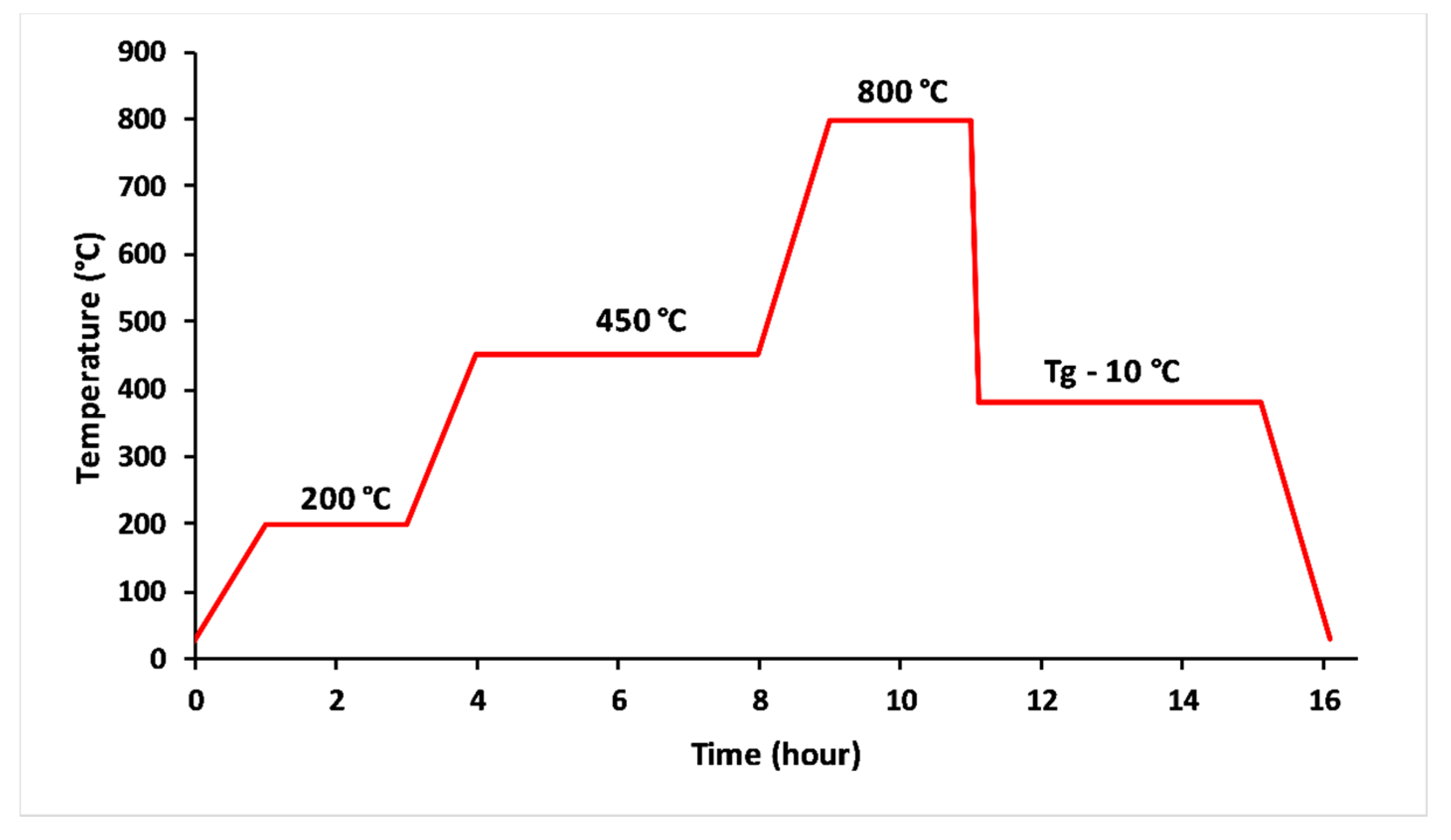
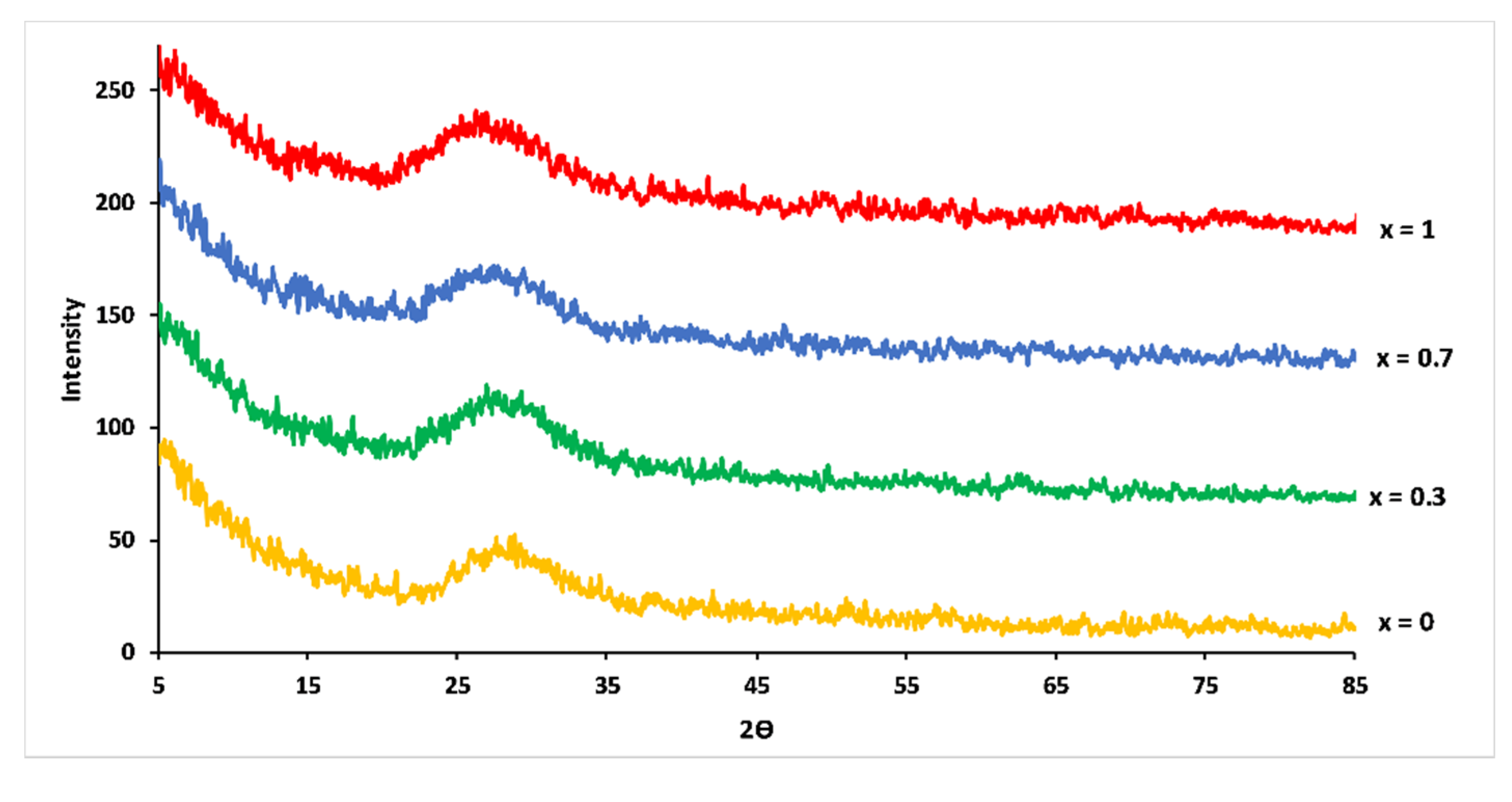
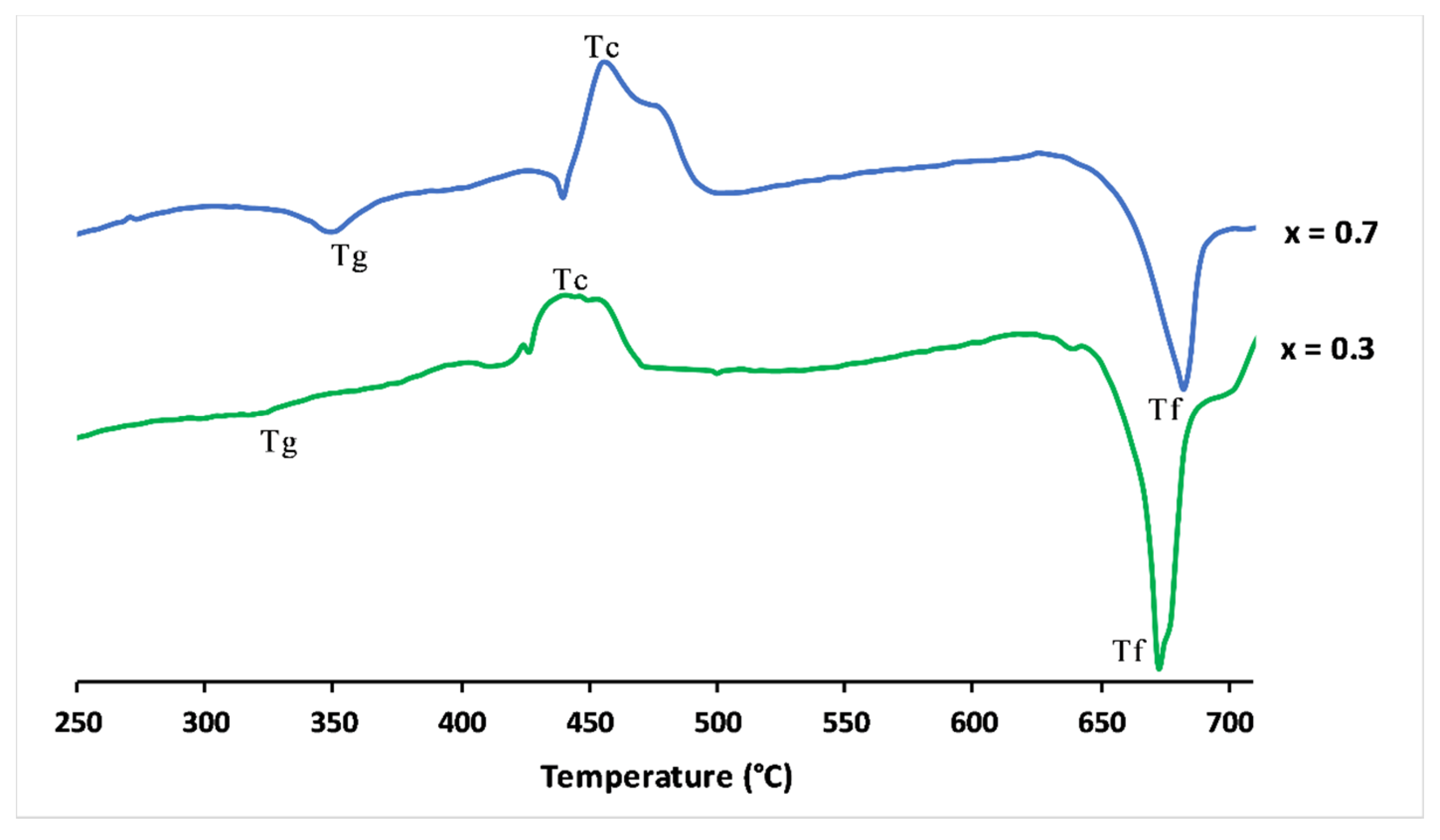

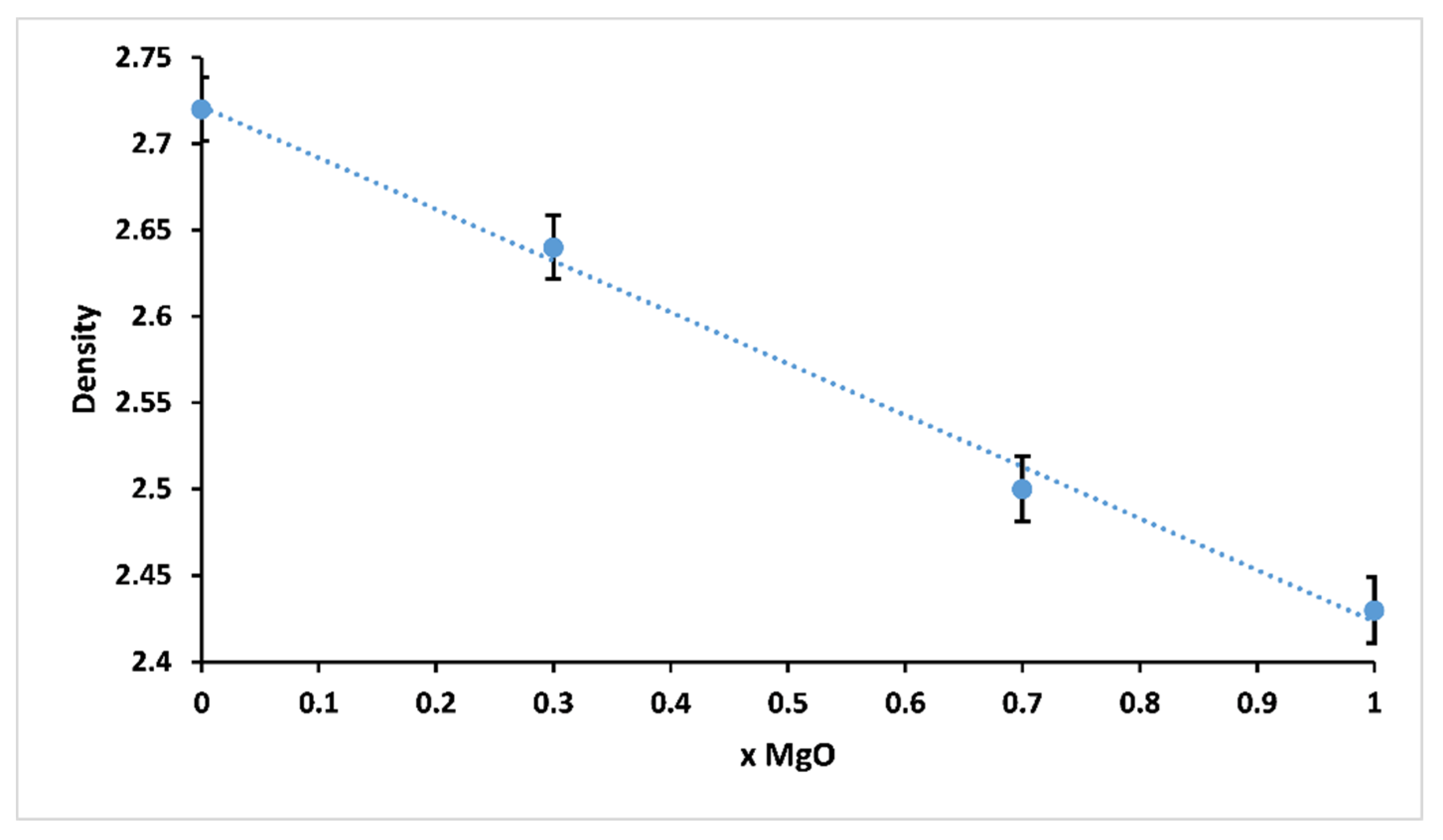
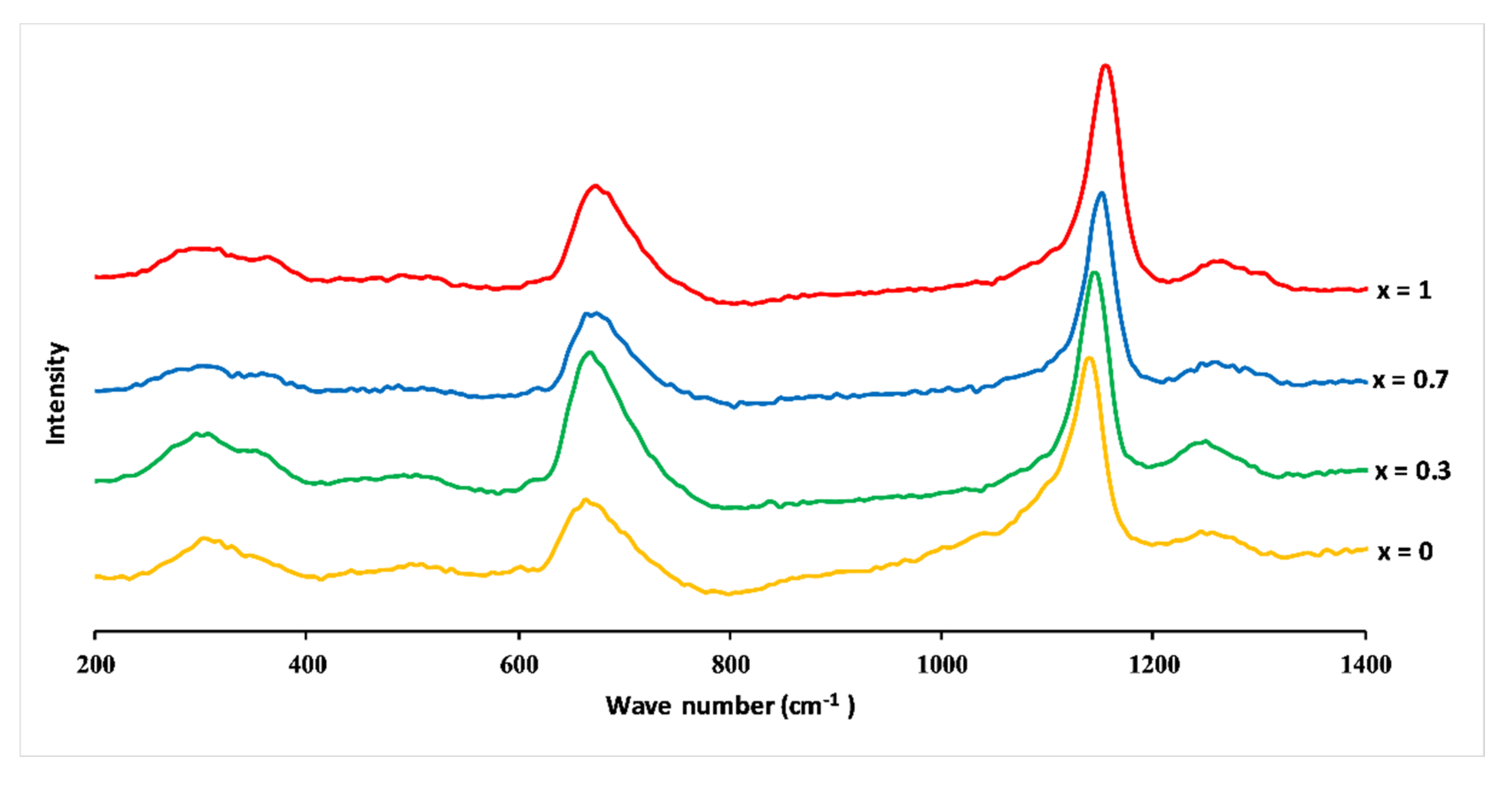

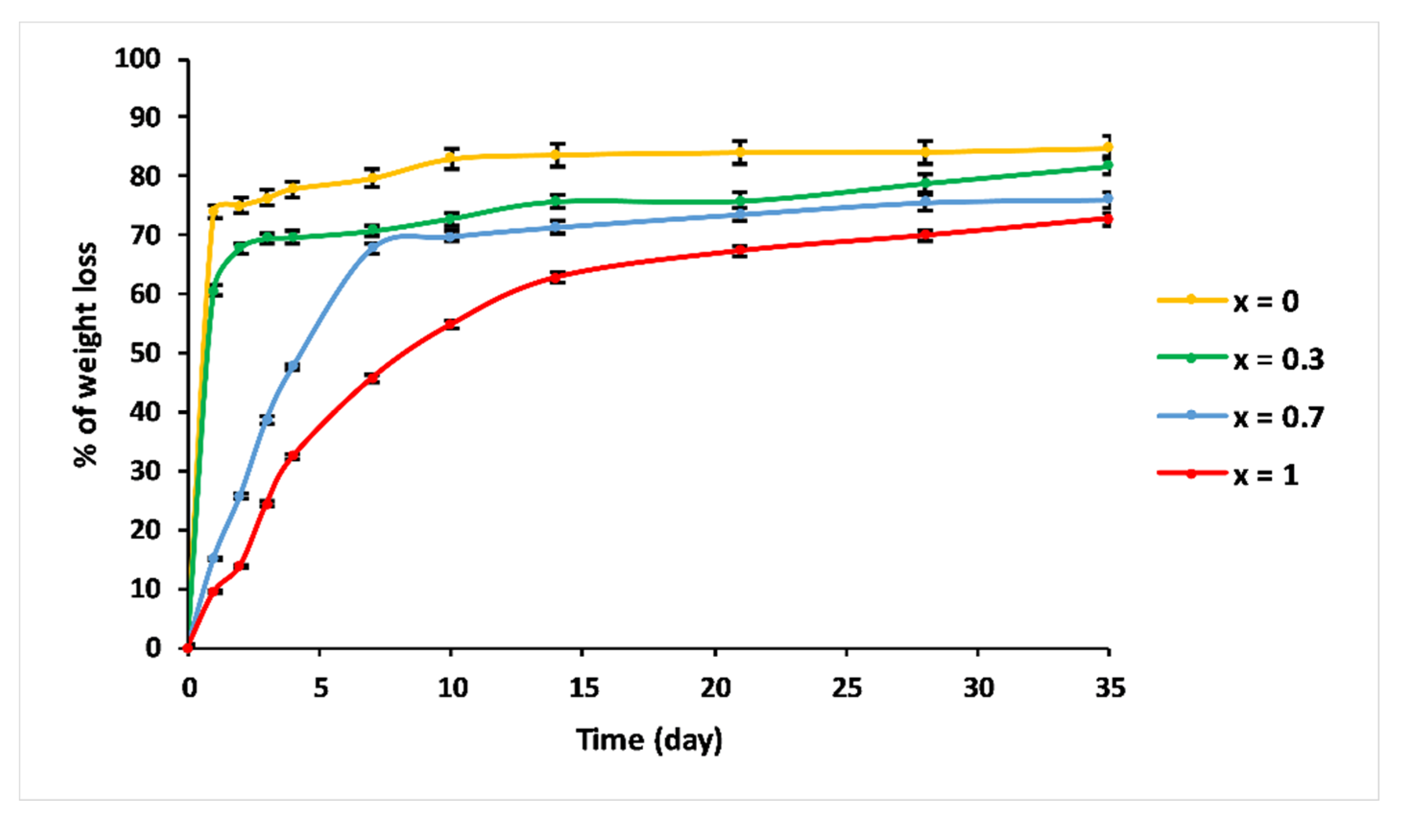

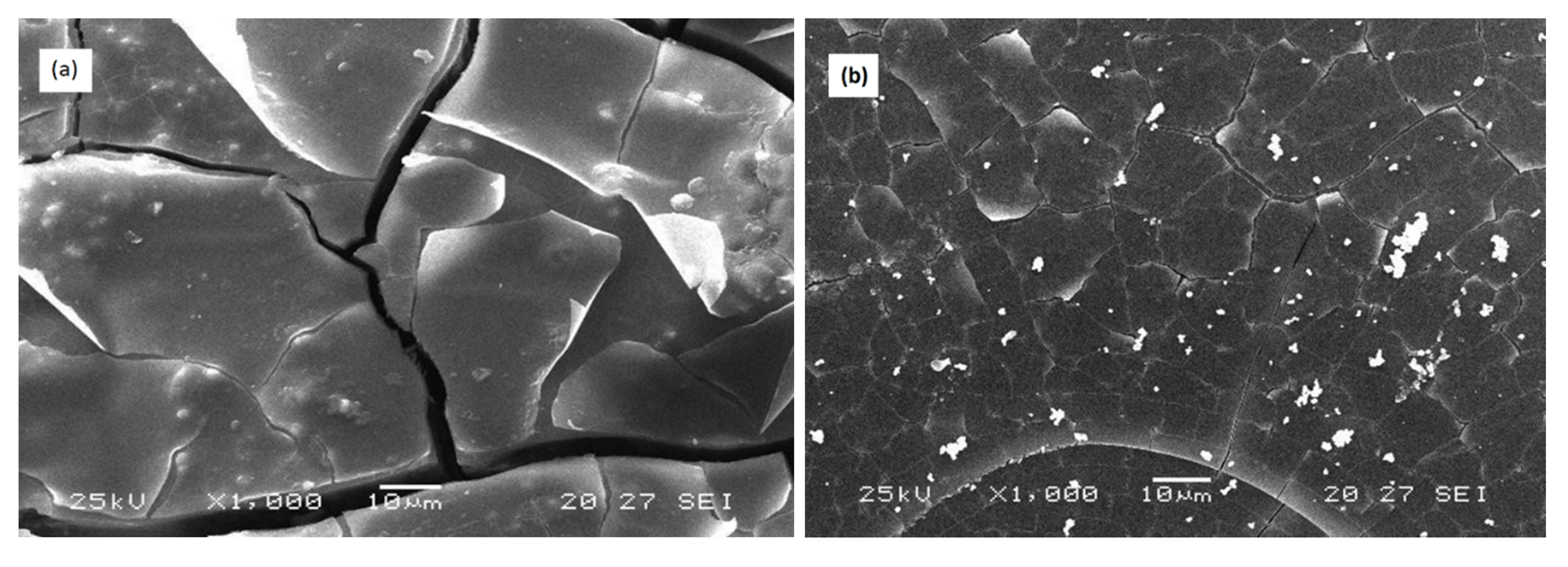
| Glass | Nominal Composition (% mol) | Analysed Composition (% mol) | ||||||
|---|---|---|---|---|---|---|---|---|
| x | P2O5 | K2O | CaO | MgO | P2O5 | K2O | CaO | MgO |
| 0 | 50 | 33.33 | 16.66 | 0 | 51.57 | 32.67 | 15.74 | 0 |
| 0.1 | 50 | 33.33 | 15 | 1.66 | 52.62 | 31.79 | 14.21 | 1.39 |
| 0.2 | 50 | 33.33 | 13.33 | 3.33 | 51.06 | 32.88 | 12.96 | 3.11 |
| 0.3 | 50 | 33.33 | 11.66 | 5 | 51.37 | 32.53 | 10.97 | 5.12 |
| 0.4 | 50 | 33.33 | 10 | 6.66 | 50.81 | 32.76 | 9.02 | 7.39 |
| 0.5 | 50 | 33.33 | 8.33 | 8.33 | 51.95 | 32.90 | 7.82 | 7.93 |
| 0.6 | 50 | 33.33 | 6.66 | 10 | 51.68 | 32.87 | 5.97 | 9.47 |
| 0.7 | 50 | 33.33 | 5 | 11.66 | 51.40 | 32.86 | 4.78 | 11.94 |
| 0.8 | 50 | 33.33 | 3.33 | 13.33 | 51.65 | 32.74 | 2.87 | 12.73 |
| 0.9 | 50 | 33.33 | 1.66 | 15 | 51.82 | 32.75 | 1.20 | 14.22 |
| 1 | 50 | 33.33 | 0 | 16.66 | 50.36 | 31.46 | 0 | 18.17 |
| x | Vas (PO2−), Q2 | Vs (PO2−), Q2 | Vs(PO32−), Q1 | Vas(PO2−), Q1 | Vas (P–O–P), Q2 | Vs (P–O–P), Q2 | δ(PO2−) | δ(PO32−) | ||||||||
|---|---|---|---|---|---|---|---|---|---|---|---|---|---|---|---|---|
| FTIR | Raman | FTIR | Raman | FTIR | Raman | FTIR | Raman | FTIR | Raman | FTIR | Raman | FTIR | Raman | FTIR | Raman | |
| 0 | 1276 | 1252 | 1145 | 1142 | 1089 | 1048 | 989–1020 | - | 867 | 879 | 721–755 | 672 | 532 | 352 | 582 | 306 |
| 0.3 | 1278 | 1255 | 1151 | 1147 | 1095 | - | 991–1026 | - | 876 | - | 723–763 | 674 | 538 | 357 | 582 | 310 |
| 0.7 | 1282 | 1263 | 1156 | 1152 | 1099 | - | 997–1031 | - | 879 | - | 723–767 | 679 | 541 | 363 | 585 | 306–318 |
| 1 | 1284 | 1268 | 1159 | 1157 | 1101 | - | 997–1031 | - | 879 | - | 725–771 | 685 | 547 | 369 | 584 | 295–326 |
| x MgO | V0 (g/day) |
|---|---|
| x = 0 | 0.74 |
| x = 0.3 | 0.607 |
| x = 0.7 | 0.1 |
| x = 1 | 0.064 |
| % of Weight Loss after 24 h | % of Weight Loss after 28 Days | % of Weight Loss after 35 Days | ||
|---|---|---|---|---|
| AAPFCO Criteria | ≤ 15% | ≤ 75% | ≥ 75% | |
| P2O5 | x = 0 | 71% | 84.5% | 84.7% |
| x = 0.3 | 60% | 81% | 81.8% | |
| x = 0.7 | 15.7% | 75.3% | 76.1% | |
| x = 1 | 10.2% | 71.6% | 72.8% | |
| K2O | x = 0 | 69.4% | 81% | 81.5% |
| x = 0.3 | 59.7% | 78.8% | 80.1% | |
| x = 0.7 | 14.9% | 74.8% | 77.5% | |
| x = 1 | 11.3% | 72.2% | 74.2% | |
| CaO | x = 0 | 72% | 81.2% | 84% |
| x = 0.3 | 61.1% | 78% | 79.3% | |
| x = 0.7 | 15.2% | 75.6% | 76.1% | |
| MgO | x = 0.3 | 46.2% | 73.5% | 77.8% |
| x = 0.7 | 15.2% | 73.8% | 74.7% | |
| x = 1 | 8.2% | 69.9% | 73.7% |
© 2020 by the authors. Licensee MDPI, Basel, Switzerland. This article is an open access article distributed under the terms and conditions of the Creative Commons Attribution (CC BY) license (http://creativecommons.org/licenses/by/4.0/).
Share and Cite
Labbilta, T.; Mesnaoui, M.; Aouad, H.; Abouliatim, Y.; Khouloud, M.; Abielaala, L. Study of the Effect of Calcium Substitution by Magnesium in the Vitreous System 3P2O5-2K2O-(1 − x) CaO-x MgO. Materials 2020, 13, 2637. https://doi.org/10.3390/ma13112637
Labbilta T, Mesnaoui M, Aouad H, Abouliatim Y, Khouloud M, Abielaala L. Study of the Effect of Calcium Substitution by Magnesium in the Vitreous System 3P2O5-2K2O-(1 − x) CaO-x MgO. Materials. 2020; 13(11):2637. https://doi.org/10.3390/ma13112637
Chicago/Turabian StyleLabbilta, Tariq, Mohamed Mesnaoui, Hakima Aouad, Younes Abouliatim, Mehdi Khouloud, and Loubna Abielaala. 2020. "Study of the Effect of Calcium Substitution by Magnesium in the Vitreous System 3P2O5-2K2O-(1 − x) CaO-x MgO" Materials 13, no. 11: 2637. https://doi.org/10.3390/ma13112637
APA StyleLabbilta, T., Mesnaoui, M., Aouad, H., Abouliatim, Y., Khouloud, M., & Abielaala, L. (2020). Study of the Effect of Calcium Substitution by Magnesium in the Vitreous System 3P2O5-2K2O-(1 − x) CaO-x MgO. Materials, 13(11), 2637. https://doi.org/10.3390/ma13112637





